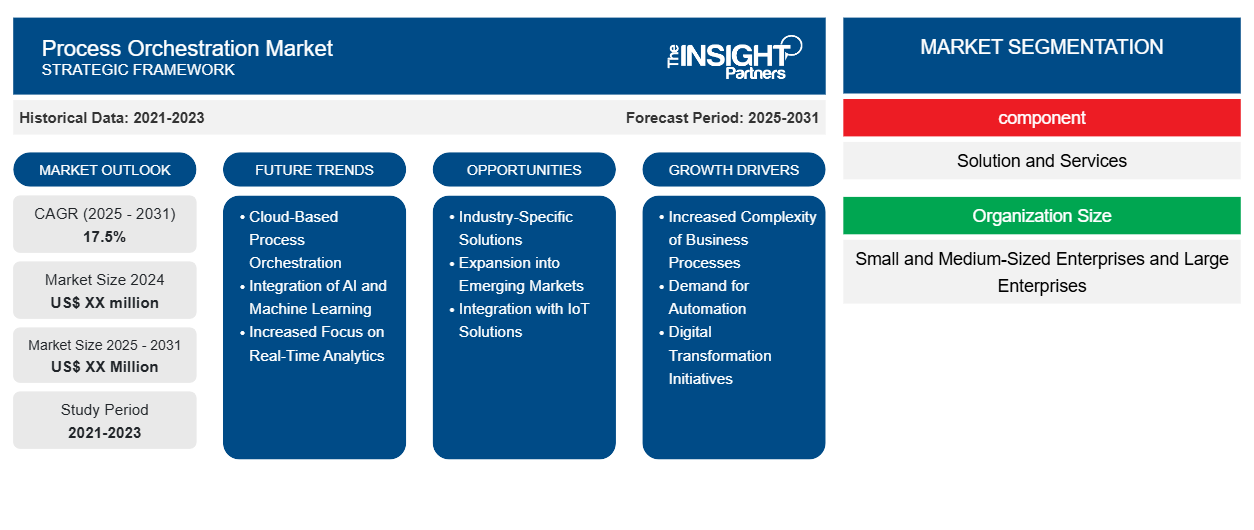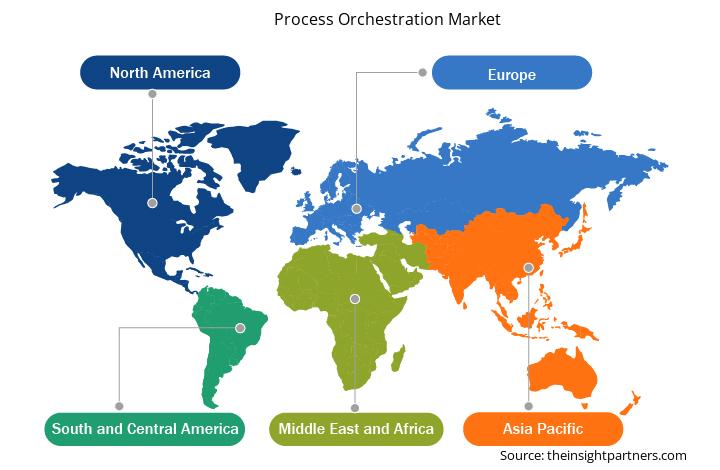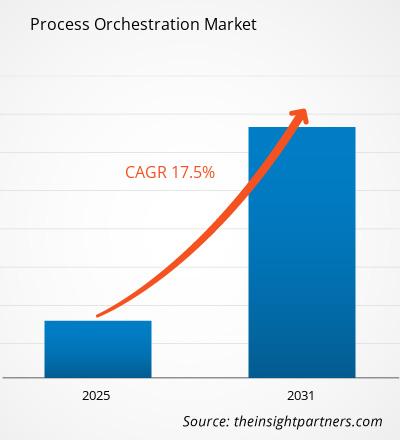プロセスオーケストレーション市場は、2025年から2031年にかけて17.5%のCAGRで成長し、市場規模は2024年のXX百万米ドルから2031年にはXX百万米ドルに拡大すると予想されています。
本レポートは、コンポーネント別(ソリューションとサービス)、組織規模別(中小企業と大企業)、業種別(BFSI、通信・IT、消費財・小売、メディア・エンターテインメント、製造、運輸・物流、エネルギー・公益事業、その他)にセグメント化されています。グローバル分析は、地域レベルと主要国別にさらに細分化されています。本レポートでは、上記の分析とセグメントについて、米ドル建てでの価値を提供しています。
報告書の目的
The Insight Partnersによるプロセスオーケストレーション市場レポートは、現状と将来の成長、主要な推進要因、課題、そして機会を解説することを目的としています。これにより、以下のような様々なビジネスステークホルダーに洞察を提供します。
- テクノロジープロバイダー/メーカー: 進化する市場の動向を理解し、潜在的な成長機会を把握することで、情報に基づいた戦略的意思決定を行うことができます。
- 投資家: 市場の成長率、市場の財務予測、バリュー チェーン全体に存在する機会に関する包括的な傾向分析を実施します。
- 規制機関: 市場の濫用を最小限に抑え、投資家の信用と信頼を維持し、市場の健全性と安定性を維持することを目的として、市場における政策と警察活動を規制します。
プロセスオーケストレーション市場のセグメンテーション
成分
- ソリューションとサービス
組織規模
- 中小企業と大企業
業界
- BFSI
- 通信・IT
- 消費財・小売
- メディアとエンターテインメント
- 製造業
- 運輸・物流
- エネルギーと公益事業
地理
- 北米
- ヨーロッパ
- アジア太平洋
- 中東およびアフリカ
- 南米と中央アメリカ
要件に合わせてレポートをカスタマイズ
このレポートの一部、国レベルの分析、Excelデータパックなど、あらゆるレポートを無料でカスタマイズできます。また、スタートアップや大学向けのお得なオファーや割引もご利用いただけます。
プロセスオーケストレーション市場:戦略的洞察

-
このレポートの主要な市場動向を入手してください。この無料サンプルには、市場動向から見積もりや予測に至るまでのデータ分析が含まれます。
プロセスオーケストレーション市場の成長要因
- ビジネスプロセスの複雑化:組織が成長し進化するにつれて、ビジネスプロセスはより複雑になり、多くの場合、様々なシステム、アプリケーション、そしてステークホルダーが関与するようになります。こうした複雑化により、ワークフローを合理化し、タスクを自動化し、部門間のシームレスなコミュニケーションを確保するプロセスオーケストレーションソリューションの必要性が高まっています。プロセスオーケストレーションは、連携と効率性を向上させることで、組織が市場の変化や運用上の課題に迅速に対応するのに役立ちます。
- 自動化の需要:ビジネスオペレーションにおける自動化の台頭は、プロセスオーケストレーション市場の大きな推進力となっています。企業は、手作業の削減と効率性の向上を目指し、ロボティック・プロセス・オートメーション(RPA)などのテクノロジーの導入をますます進めています。プロセスオーケストレーションソリューションは、これらの自動化ツールを統合することで、より包括的なワークフロー管理を可能にし、企業のリソース配分の最適化と生産性向上を実現します。
- デジタルトランスフォーメーションへの取り組み:業界全体で進行中のデジタルトランスフォーメーションは、組織に業務戦略の見直しを迫っています。プロセスオーケストレーションは、異種システムを連携させ、プロセスの俊敏性と適応性を確保することで、この変革において重要な役割を果たします。デジタル化への取り組みを優先する企業が増えるにつれ、効果的なオーケストレーションソリューションへの需要は高まり続け、デジタルファーストの業務へのスムーズな移行を促進します。
プロセスオーケストレーション市場の将来動向
- クラウドベースのプロセスオーケストレーション:クラウド導入のトレンドは、プロセスオーケストレーションのあり方を大きく変えつつあります。組織は、柔軟性、拡張性、そしてコスト効率の向上を目指して、クラウドベースのソリューションをますます活用しています。クラウドベースのオーケストレーションプラットフォームは、オンプレミスとクラウドアプリケーションをまたいでプロセスを統合し、場所を問わずシームレスなデータフローとチーム間のコラボレーションの向上を実現します。
- AIと機械学習の統合:プロセスオーケストレーションソリューションへの人工知能(AI)と機械学習(ML)の統合が急速に進んでいます。これらのテクノロジーは、データパターンの分析、プロセス結果の予測、複雑なタスクの自動化を通じて意思決定能力を強化します。組織はAI主導のインサイトを活用してワークフローを最適化し、効率性を向上させ、プロセスをリアルタイムに適応させることで、全体的なパフォーマンスを大幅に向上させています。
- リアルタイム分析への注目度の高まり:プロセスオーケストレーションソリューションにおいて、リアルタイム分析の重要性が高まっています。組織は、プロセスパフォーマンスを即座に可視化し、ボトルネックや非効率性を迅速に特定できるツールを求めています。リアルタイム監視へのこうしたトレンドは意思決定の強化につながり、企業が問題に積極的に対応し、プロセスを継続的に改善することを可能にします。
プロセスオーケストレーションの市場機会
- 業界特化型ソリューション:プロセスオーケストレーションプロバイダーにとって、医療、金融、製造など、様々な業種特有のニーズに合わせてカスタマイズされた業界特化型ソリューションを開発する大きなチャンスがあります。規制要件、運用上の課題、業界のベストプラクティスに対応する専門的なオーケストレーションツールを提供することで、プロバイダーはニッチ市場を獲得し、競合他社との差別化を図ることができます。
- 新興市場への進出:プロセスオーケストレーション市場は、組織によるデジタル技術の導入が進む新興市場において、大きな成長ポテンシャルを秘めています。これらの地域の企業は業務の最適化を目指しており、プロセスオーケストレーションソリューションは、ワークフローの合理化と効率性の向上に必要なツールを提供します。これらの市場をターゲットにすることで、プロバイダーは新たな収益源を開拓することができます。
- IoTソリューションとの統合:モノのインターネット(IoT)デバイスの普及は、プロセスオーケストレーションプロバイダーにとって、自社のソリューションをIoTテクノロジーと統合する好機となっています。デバイスとシステム間のリアルタイムのデータ交換と自動化を可能にするオーケストレーションソリューションは、製造、物流、スマートシティなど、様々な業界において、運用効率を向上させ、データに基づく意思決定を促進します。
プロセスオーケストレーション市場の地域別分析
Insight Partnersのアナリストは、予測期間全体を通してプロセスオーケストレーション市場に影響を与える地域的なトレンドと要因を詳細に解説しています。このセクションでは、北米、ヨーロッパ、アジア太平洋、中東・アフリカ、中南米におけるプロセスオーケストレーション市場のセグメントと地域についても解説します。

- プロセスオーケストレーション市場の地域別データを入手
プロセスオーケストレーション市場レポートの範囲
| レポート属性 | 詳細 |
|---|---|
| 2024年の市場規模 | XX百万米ドル |
| 2031年までの市場規模 | XX百万米ドル |
| 世界のCAGR(2025年~2031年) | 17.5% |
| 履歴データ | 2021-2023 |
| 予測期間 | 2025~2031年 |
| 対象セグメント |
コンポーネント別
|
| 対象地域と国 |
北米
|
| 市場リーダーと主要企業の概要 |
|
プロセスオーケストレーション市場のプレーヤー密度:ビジネスダイナミクスへの影響を理解する
プロセスオーケストレーション市場は、消費者の嗜好の変化、技術の進歩、製品メリットへの認知度の向上といった要因によるエンドユーザー需要の高まりに牽引され、急速に成長しています。需要が高まるにつれ、企業は提供内容を拡大し、消費者ニーズを満たすためのイノベーションを推進し、新たなトレンドを捉えることで、市場の成長をさらに加速させています。
市場プレーヤー密度とは、特定の市場または業界内で事業を展開する企業または会社の分布を指します。これは、特定の市場空間における競合企業(市場プレーヤー)の数が、その市場規模または市場価値全体と比較してどれだけ多いかを示します。
プロセスオーケストレーション市場で事業を展開している主要企業は次のとおりです。
- SAP
- IBM
- オラクル
- シスコ
- CAテクノロジーズ
免責事項:上記の企業は、特定の順序でランク付けされているわけではありません。

- プロセスオーケストレーション市場のトップキープレーヤーの概要を入手
主なセールスポイント
- 包括的なカバレッジ: レポートでは、プロセス オーケストレーション市場の製品、サービス、タイプ、エンド ユーザーの分析を包括的にカバーし、全体的な概要を提供します。
- 専門家の分析:レポートは、業界の専門家とアナリストの深い理解に基づいて作成されています。
- 最新情報: このレポートは、最新の情報とデータの傾向を網羅しているため、ビジネスの関連性を保証します。
- カスタマイズ オプション: このレポートは、特定のクライアント要件に対応し、ビジネス戦略に適切に適合するようにカスタマイズできます。
したがって、プロセスオーケストレーション市場に関する調査レポートは、業界の状況と成長見通しを解明し、理解するための先導役となるでしょう。いくつかの妥当な懸念事項はあるものの、このレポートの全体的なメリットはデメリットを上回る傾向にあります。
- 過去2年間の分析、基準年、CAGRによる予測(7年間)
- PEST分析とSWOT分析
- 市場規模価値/数量 - 世界、地域、国
- 業界と競争環境
- Excel データセット
最新レポート
お客様の声
購入理由
- 情報に基づいた意思決定
- 市場動向の理解
- 競合分析
- 顧客インサイト
- 市場予測
- リスク軽減
- 戦略計画
- 投資の正当性
- 新興市場の特定
- マーケティング戦略の強化
- 業務効率の向上
- 規制動向への対応






















 無料サンプルを入手 - プロセスオーケストレーション市場
無料サンプルを入手 - プロセスオーケストレーション市場